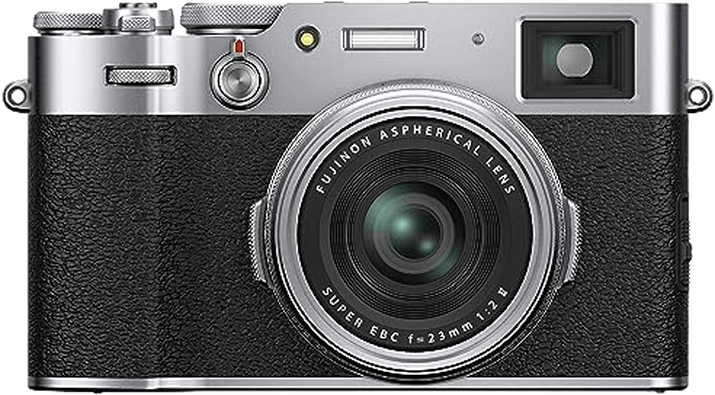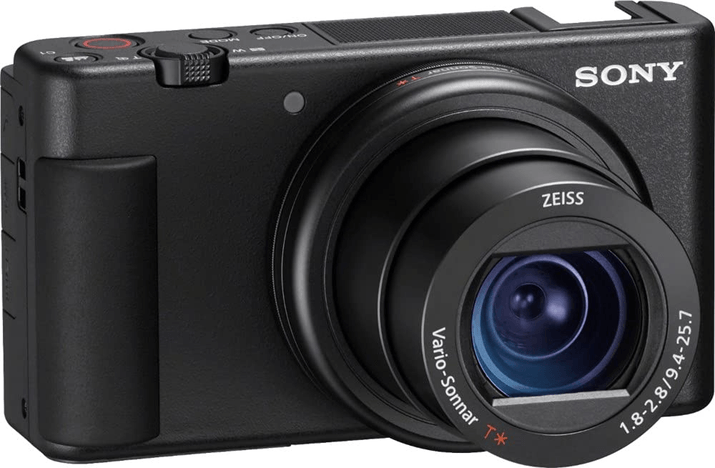Fujifilm X100V vs Sony ZV-1 Comparison
Fujifilm X100V

Sony ZV-1

The Fujifilm X100V outperforms the Sony ZV-1 with a score of 69/100 compared to 65/100. Both cameras were released in 2020 and share common specifications like camera type and announcement date. The X100V, a mirrorless camera, has a higher launch price of $1399 and is larger and heavier at 128 x 75 x 53mm and 478g. The higher score reflects its superior performance.
On the other hand, the Sony ZV-1 is a compact camera with a lower launch price of $800 and a smaller, lighter design at 105 x 60 x 44mm and 294g. Despite its lower score, the ZV-1 offers a more affordable and portable option for photographers.
Considering the specifications and scores, the Fujifilm X100V is the better camera in terms of performance, while the Sony ZV-1 provides a more budget-friendly and compact alternative.
Fujifilm X100V vs Sony ZV-1 Overview and Optics
The Sony ZV-1 narrowly wins in the optics comparison with a score of 67/100, compared to the Fujifilm X100V’s 66/100. Both cameras share common specifications, including a CMOS sensor type, fixed lens mount, and the inability to change lenses. However, there are key differences that set them apart.
The Fujifilm X100V boasts a higher megapixel count at 26, compared to the Sony ZV-1’s 20, which allows for more detailed and higher resolution images. Additionally, it features an X-Processor 4, and its sensor size is APS-C, larger than the Sony ZV-1’s 1″ sensor. The larger sensor size contributes to better image quality, particularly in low-light conditions. However, the X100V lacks image stabilization, which can lead to blurry images if the camera is not held steady.
In contrast, the Sony ZV-1 has a faster shooting speed of 24 frames per second, compared to the Fujifilm X100V’s 11. This enables the ZV-1 to capture fast-moving subjects more effectively. It also features a Bionz X processor and has a DXOMARK score of 82 for its sensor. The ZV-1 includes image stabilization, which helps to minimize camera shake and produce sharper images.
Despite the Fujifilm X100V’s higher megapixel count and larger sensor size, the Sony ZV-1’s faster shooting speed and image stabilization make it a more versatile camera for various shooting situations. The ZV-1’s slightly higher optics score reflects its better overall performance in this comparison. However, the X100V’s superior resolution and low-light capabilities should not be overlooked, as they may be preferable for specific photographic needs.
Fujifilm X100V vs Sony ZV-1 Video Performance
The Fujifilm X100V and the Sony ZV-1 share the same video score of 91/100, indicating that both cameras possess impressive video capabilities. Both cameras offer 4K video resolution, 120fps maximum video frame rate, and built-in time-lapse functionality. However, the Fujifilm X100V has a slight edge over the Sony ZV-1 in terms of maximum video dimensions, boasting 4096 x 2160 pixels compared to the ZV-1’s 3840 x 2160 pixels.
The Fujifilm X100V’s higher video dimensions provide users with more flexibility in post-production, allowing for better cropping and scaling options without losing image quality. This advantage makes the X100V a more suitable choice for professionals and enthusiasts who require a higher level of control over their video output.
On the other hand, the Sony ZV-1 offers comparable video performance in most aspects, making it a solid option for those seeking a camera with excellent video capabilities. While its maximum video dimensions are slightly lower than the X100V, the difference may not be significant for casual users or those who prioritize other features in their camera.
Both the Fujifilm X100V and the Sony ZV-1 are strong contenders in the realm of video performance. The X100V’s slightly higher video dimensions make it a better choice for those seeking more post-production flexibility, while the ZV-1 remains a reliable option for users who prioritize other aspects of their camera. Ultimately, the choice between these two cameras will depend on the specific needs and preferences of the individual user.
Fujifilm X100V vs Sony ZV-1 Features and Benefits
The Fujifilm X100V emerges as the winner with a feature score of 85/100, compared to the Sony ZV-1’s score of 68/100. Both cameras share several specifications, including a 3-inch screen, touchscreen capabilities, flip screen, lack of GPS, and the presence of WiFi and Bluetooth connectivity.
The X100V outperforms the ZV-1 in screen resolution, offering 1,620,000 dots compared to the ZV-1’s 921,600 dots. This higher resolution provides a sharper and clearer display on the X100V, enhancing the overall user experience.
On the other hand, the Sony ZV-1 still possesses valuable features, such as its touchscreen, flip screen, WiFi, and Bluetooth capabilities, making it a viable option for those seeking a camera with these specifications. However, the lower feature score and screen resolution are noticeable drawbacks.
Taking into account each camera’s strengths and weaknesses, the Fujifilm X100V stands out as the superior option due to its higher feature score and better screen resolution. While the Sony ZV-1 offers similar features, the X100V’s enhanced display quality sets it apart, making it a more attractive choice for photographers and videographers alike.
Fujifilm X100V vs Sony ZV-1 Storage and Battery
The Fujifilm X100V outperforms the Sony ZV-1 in storage and battery with a score of 37/100 compared to the latter’s 29/100. Both cameras share similarities in storage, offering a single memory card slot and accepting SD, SDHC, and SDXC cards. Additionally, they both support USB charging.
The X100V excels with its longer battery life of 420 shots, using the NP-W126S battery type. This makes it a more reliable option for longer shooting sessions. On the other hand, the ZV-1 can only deliver 260 shots per charge with its NP-BX1 battery.
However, the Sony ZV-1 has an advantage in accepting Memory Stick Pro Duo and Pro-HG Duo cards, providing more versatility in storage options. Despite this, the Fujifilm X100V remains the superior choice for storage and battery performance. Both cameras have their strengths, but the X100V’s longer battery life gives it the edge in this comparison.
Fujifilm X100V vs Sony ZV-1 – Our Verdict
Are you still undecided about which camera is right for you? Have a look at these popular comparisons that feature the Fujifilm X100V or the Sony ZV-1:

